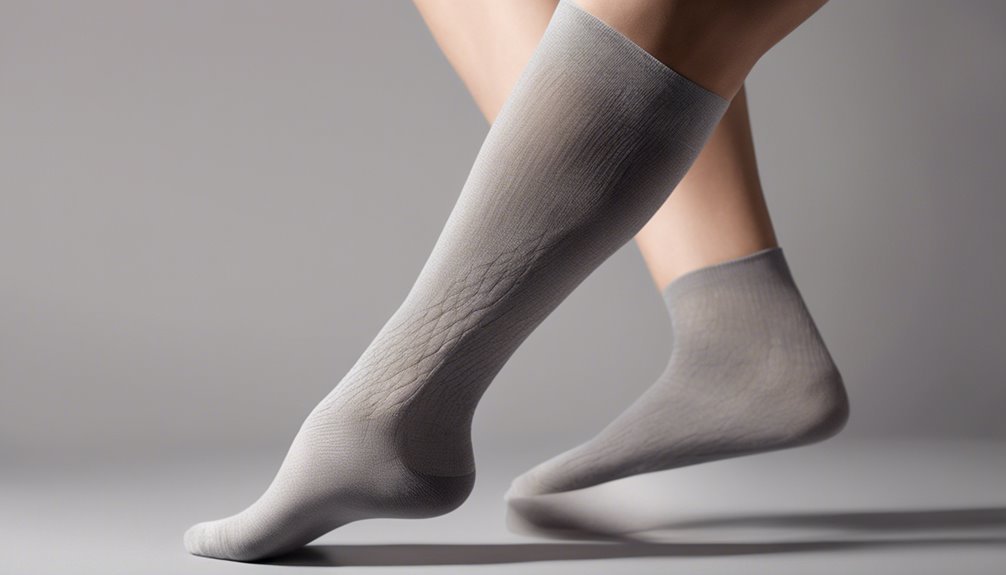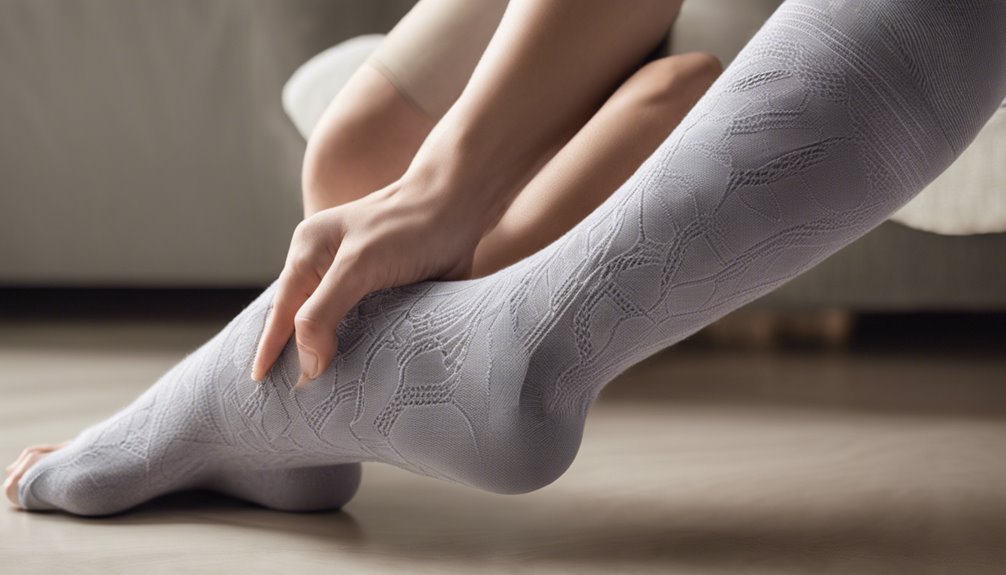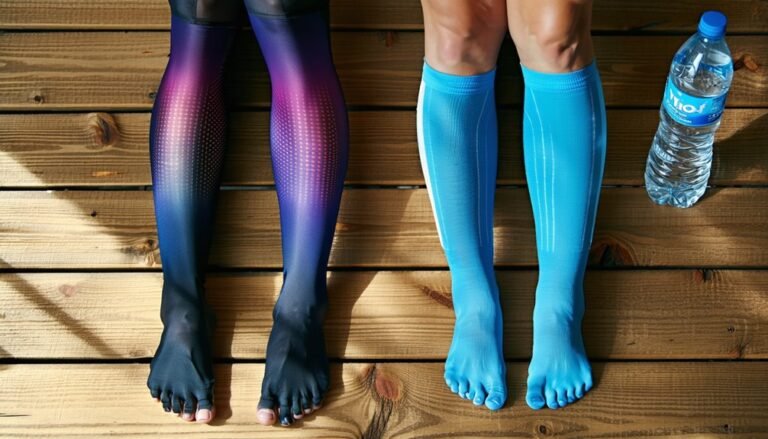How Compression Socks Improve Circulation & Prevent Swelling
Imagine this: You've just returned home after a long day of standing at work, your legs feeling like they weigh a ton each.
What if there was a simple solution to alleviate that discomfort and prevent swelling? Compression socks are designed to improve venous circulation and prevent swelling through graduated pressure technology.
The strongest compression at your ankles gradually decreases up your leg, encouraging blood to flow back to your heart and reducing fluid buildup in your limbs. This mechanism alleviates symptoms like leg fatigue and edema, enhancing freedom of movement.
They're essential for individuals with conditions like venous insufficiency or for those who stand long hours.
Discover more about optimizing your vascular health with these innovative socks.
Understanding the Mechanics of Compression Socks

When considering the mechanics of compression socks, it is essential to understand how they function to promote circulation. These socks come in various compression sock types, each designed to target specific areas of your legs. Graduated compression socks, for instance, apply pressure that is strongest at the ankle and decreases as it moves up the leg. This pressure gradient supports venous return, helping blood flow back to the heart more efficiently. You're likely to experience less fatigue and swelling, granting you the freedom to move with ease. The circulation mechanics behind these socks involve enhancing tissue perfusion and reducing venous stasis. By choosing the right type, you can address your unique needs, ensuring ideal comfort and vascular health.
The Science of Improved Blood Circulation
When you wear compression socks, the pressure gradient mechanics play an essential role in enhancing venous blood flow by applying graduated pressure to your legs. This carefully calibrated compression aids in effectively pushing deoxygenated blood back to your heart, reducing venous stasis. As a result, you'll experience optimized oxygen delivery to your tissues, promoting overall circulatory health.
Pressure Gradient Mechanics
Although often overlooked, the mechanics of pressure gradients play a significant role in how compression socks enhance blood circulation. By employing precise pressure application, these socks create graduated compression levels, essential for optimizing venous return. The highest compression is typically applied at the ankle, gradually decreasing up the leg. This pressure gradient is fundamental in counteracting gravitational forces that can impede blood flow. It helps to narrow the vessel diameter, effectively increasing venous blood velocity and enhancing circulation. As a result, you experience reduced leg fatigue and swelling, empowering you with greater freedom of movement. Understanding this anatomical mechanism allows you to make informed choices, selecting compression levels tailored to your individual needs and lifestyle, ensuring both comfort and efficacy.
Venous Blood Flow Enhancement
Understanding the pressure gradient mechanics is just one piece of the puzzle in comprehending how compression socks enhance venous blood flow. When you wear these socks, they apply graduated pressure on your lower limbs, increasing from the ankle upwards. This design aids in promoting efficient venous return by counteracting the effects of gravity on blood flow.
The increased external pressure helps maintain ideal blood pressure within your veins, reducing venous pooling and preventing swelling. It's essential for you to experience the freedom of movement without worrying about circulatory issues. Compression socks support your body's natural return of deoxygenated blood to the heart. By improving venous blood flow, they facilitate a more dynamic and healthier circulatory system, empowering you to stay active with ease.
Oxygen Delivery Optimization
To enhance oxygen delivery, compression socks play an essential role in improving blood circulation by supporting the efficient transport of oxygenated blood to your tissues. By applying graduated pressure, these socks facilitate improved oxygen transport, guaranteeing your muscles and organs receive adequate blood oxygenation.
Key benefits include:
- Enhanced Venous Return: Encourages blood flow back to the heart, boosting systemic circulation.
- Reduced Venous Stasis: Minimizes blood pooling in lower extremities, preventing swelling.
- Improved Endothelial Function: Supports the inner lining of blood vessels, promoting vasodilation.
- Increased Tissue Perfusion: Guarantees ideal delivery of nutrients and oxygen to cells.
- Decreased Lactic Acid Build-Up: Helps clear metabolic waste, reducing fatigue.
Reducing Swelling With Compression Therapy
Swelling, medically known as edema, often results from poor circulation, and compression therapy is a proven method to alleviate it. By applying gentle pressure, compression socks promote swelling reduction, helping blood flow efficiently back to your heart. This compression benefits your venous system, reducing discomfort and enhancing your freedom of movement.
| Condition | Symptom | Compression Benefit |
|---|---|---|
| Poor circulation | Edema | Swelling reduction |
| Venous insufficiency | Leg heaviness | Improved blood return |
| Prolonged standing | Ankle swelling | Enhanced venous function |
You deserve to move freely without the burden of swollen limbs. Compression therapy not only assists in maintaining vascular health but also supports your lifestyle. Prioritizing your circulatory health is a step towards unrestrained living, leveraging anatomical precision to keep you on your feet.
Athletic Benefits of Wearing Compression Socks

As an athlete, you understand the importance of optimizing muscle recovery and minimizing injury risk. Wearing compression socks can enhance venous return, reducing muscle fatigue and facilitating more efficient recovery. By stabilizing muscles and supporting proper alignment, these socks may decrease the likelihood of strain or injury during physical activity.
Enhanced Muscle Recovery
Athletes often seek ways to optimize performance and speed up recovery, and compression socks can be a valuable tool in this pursuit. These specialized garments help manage muscle soreness and decrease recovery time by enhancing venous return and reducing lactic acid buildup. By applying graduated pressure, compression socks improve circulation, ensuring oxygen-rich blood nourishes your muscles, facilitating faster healing.
Here's how they can enhance muscle recovery:
- Reduce muscle soreness by minimizing micro-tears.
- Accelerate recovery time by promoting efficient blood flow.
- Decrease inflammation through targeted compression.
- Support muscle tissue with consistent pressure.
- Enhance lymphatic drainage to remove metabolic waste.
Incorporating compression socks into your regimen can empower you to recover more swiftly, allowing you the freedom to pursue your athletic goals with renewed vigor.
Reduced Injury Risk
Embrace the advantages of compression socks to greatly lower your risk of injury during athletic activities. These socks offer strategic muscle support, stabilizing muscles like the gastrocnemius and soleus, reducing the strain that leads to common injuries. By promoting ideal blood flow and oxygen delivery, they help maintain muscle integrity and facilitate effective injury prevention. You'll find that compression socks act as a safeguard, minimizing micro-tears and muscle oscillation, which are precursors to more severe damage.
Moreover, they support proprioception, enhancing your body's awareness and control, essential for avoiding missteps and injuries. With freedom to pursue your athletic endeavors, you can rely on compression socks to bolster your performance while prioritizing injury prevention. Trust in their ability to keep you resilient and active.
Compression Socks for Travel-Related Issues
Long flights or extended road trips can often leave you with swollen legs and uncomfortable pressure in your lower extremities, but compression socks offer a practical solution to these travel-related circulation issues. By applying gentle pressure to your calves, these socks enhance venous return, countering the effects of prolonged immobility. This helps prevent venous stasis, where blood pools in the lower legs, reducing travel discomfort and the risk of deep vein thrombosis (DVT).
Consider these benefits:
- Improved blood flow: Enhances oxygen delivery to tissues.
- Reduced swelling: Alleviates edema by promoting lymphatic drainage.
- Comfort: Minimized leg fatigue during long journeys.
- Versatile fit: Available in various styles to suit personal preferences.
- Freedom to move: Encourages gentle movement even in confined spaces.
Embrace the freedom of travel with the proactive care compression socks provide.
Managing Medical Conditions With Compression Socks

When managing specific medical conditions, such as chronic venous insufficiency or lymphedema, compression socks can be an essential component of your treatment plan. These socks apply graduated pressure, aiding venous return and reducing edema. By enhancing blood flow, they can alleviate symptoms like heaviness and pain.
| Condition | Symptom Relief | Compression Benefit |
|---|---|---|
| Chronic Venous Insufficiency | Reduces leg swelling | Improves venous return |
| Lymphedema | Decreases limb volume | Enhances lymph drainage |
| Deep Vein Thrombosis | Prevents clot extension | Supports venous flow |
| Varicose Veins | Eases heaviness | Promotes circulation |
Compression therapy empowers you to take control of your health, offering a non-invasive solution with profound benefits. As you embrace this freedom, ascertain your healthcare provider helps tailor the right approach to fit your needs.
Choosing the Right Compression Level and Fit
Understanding how compression socks can aid in managing medical conditions naturally leads to the question of selecting the appropriate compression level and fit. When choosing, take into account your specific needs. Compression levels, measured in millimeters of mercury (mmHg), vary based on medical requirements. A proper fit guarantees ideal blood flow, reducing venous pressure and preventing edema. Here's what to keep in mind:
- Mild (8-15 mmHg): Suitable for daily wear, reducing minor swelling.
- Moderate (15-20 mmHg): Ideal for those standing for extended periods.
- Firm (20-30 mmHg): Common for managing varicose veins or post-surgery.
- Extra Firm (30-40 mmHg): Typically prescribed for severe conditions.
- Accurate sizing: Guarantees comfort and effectiveness, preventing constriction.
Choosing wisely supports your freedom to engage in daily activities without discomfort, promoting vascular health.
Caring for Your Compression Socks
Proper care is essential for maintaining the function and longevity of your compression socks. To guarantee peak venous return and prevent edema, prioritize regular sock washing. Use lukewarm water and a mild detergent to preserve the elasticity of the fibers, which is critical for effective compression. Avoid fabric softeners, as they can degrade the material's integrity. When drying, air dry your socks to maintain their anatomical fit, as heat from dryers may compromise fabric care and reduce compression efficiency. By taking these steps, you'll enhance circulation, prevent swelling, and enjoy the freedom of movement without constraint. Remember, well-maintained socks translate to better health outcomes and increased autonomy in your daily activities. Treat your compression socks as an investment in your vascular health.
Frequently Asked Questions
Can Compression Socks Be Worn While Sleeping?
Imagine your legs as a garden hose. Night usage of compression socks can guarantee consistent blood flow like water through the hose, providing sleeping benefits. While not always recommended, they can be beneficial for specific conditions.
Are There Any Side Effects of Wearing Compression Socks?
You might experience skin irritation or restricted blood flow if compression socks are too tight or worn improperly. Guarantee proper fit and consult a healthcare provider to enjoy the benefits while minimizing potential side effects.
How Long Should Compression Socks Be Worn Each Day?
You should wear compression socks for a daily duration of 6-8 hours. Guarantee an ideal fit to promote venous return and prevent edema. Listen to your body's cues, allowing personal freedom in determining your comfort level.
Do Compression Socks Help With Varicose Veins?
Imagine a gentle, supportive embrace wrapping around your legs, subtly easing discomfort. Compression socks, with their varying compression levels, can alleviate symptoms of varicose veins by promoting venous return and reducing venous pressure, granting you more comfort and freedom.
Can Compression Socks Be Used During Pregnancy?
You're likely considering compression socks during pregnancy for their benefits. They're generally safe, promoting venous return and reducing edema. Always consult your healthcare provider to verify they're appropriate for your anatomy and personal pregnancy safety needs.






